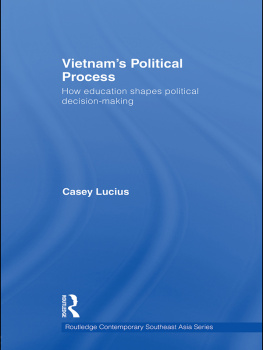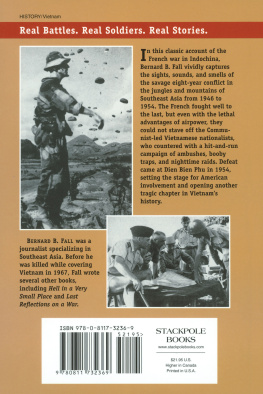A Westview Encore Reprint
THE TWO VIET-NAMS
A POLITICAL AND MILITARY ANALYSIS

THE TWO VIET-NAMS
The Two Viet-Nams
A Political and Military Analysis
SECOND REVISED EDITION
Bernard B. Fall
First published 1984 by Westview Press, Inc.
Published 2019 by Routledge
52 Vanderbilt Avenue, New York, NY 10017
2 Park Square, Milton Park, Abingdon, Oxon OX14 4RN
Routledge is an imprint of the Taylor & Francis Group, an informa business
Copyright 1984 by Dorothy Fall
All rights reserved. No part of this book may be reprinted or reproduced or utilised in any form or by any electronic, mechanical, or other means, now known or hereafter invented, including photocopying and recording, or in any information storage or retrieval system, without permission in writing from the publishers.
Notice:
Product or corporate names may be trademarks or registered trademarks, and are used only for identification and explanation without intent to infringe.
Library of Congress Catalog Card Number: 84-52191
ISBN 13: 978-0-367-29672-8 (hbk)
To
THE VALIANT AND LONG-SUFFERING
VIETNAMESENORTH AND SOUTH
THIS is a book in praise of no one. I have written it not to plead a cause or to propound a pet theory, but simply to attempt to bring some understanding to the plight of a valiant people that happens to find itself, no doubt much against its will, at one of the focal points of a world-wide struggle.
It may well be that many readers will draw from this book the impression that numerous young television viewers draw from seeing either a "Western" or a Shakespearean tragedy: "Everybody gets killed in the end." Or, in the case of divided Viet-Nam, that life is not exactly pleasant in either zone of Viet-Nam; that each zone has its own set of economic and political troubles; and that both sides are engaged in military efforts which, having grown beyond their own control, may well overwhelm them in the end.
This seems to be, alas, the case at this writing, and it is unlikely to improve in the immediately foreseeable future. And again in the manner of most human tragedies, there are in both zones heroes with some fairly villainous character traits and some villains with a few likable human characteristics, but above all, there are the Vietnamese people, with their admirable qualities of frugality, incredible endurance, patience in the face of unavoidable adversity, and deep love for their war-torn homeland.
An important part of this bookand I hope this will be its particular contribution to the body of knowledge about Viet-Namis devoted to a comparison of the governmental and economic institutions of both zones not as they have been designed on paper to impress their friends and fool their foes, but as they really operate in everyday practice. This may not please the most ardent advocates of either regime, but the time for semantic nicetiesif there ever was such a time in Viet-Namis long past. The weaknesses and strengths of each zone of Viet-Nam deserve our most careful attention; for, at a time when American and allied troops are deeply committed to what Senator Mansfield has called an "open-ended war," what we don't know may most definitely hurt us. Chances are it already has.
A great deal has changed in both Viet-Nams since the first edition of this book appeared, in 1963, shortly before the overthrow and assassination of Ngo Dinh Diem. A limited insurgency involving 25,000 lightly armed guerrillas on one side and South Vietnamese troops backed by only a few hundred American advisers on the other has mushroomed into the third largest international war of the century, involving the combatants of ten nations and an area far larger than Korea. This fully revised edition reflects these changes and attempts to draw some preliminary conclusions from current developments.
Present appearances to the contrary, it is not easy to become an "expert" on Viet-Nam. This book and its revisions are the result of a continuous research and re-evaluation process. Some of its elements go back to my earliest stay as a student in Hanoi in 1953; others to my travels with Vietnamese units in the Mekong Delta in 1965; and still others to conversations with a specialist who may have come back from Viet-Nam the week before. It would, therefore, be difficult to acknowledge any particular thanks to a few persons without being unfair to many othersVietnamese of all political persuasions, Americans, Frenchwho have, in one way or another, made invaluable contributions to this book. I am also grateful to such scholarly critics as P. J. Honey and I. Milton Sacks who drew my attention to inadvertent errors or shortcomings in previous editions. Finally, I wish to thank Phyllis Freeman for patiently coping with the vagaries of a manuscript arriving piecemeal from the Far East.
Part of the field research for the first edition of this book was carried out under an International Relations research grant of the Rockefeller Foundation, for which I wish to acknowledge my gratitude. The Foundation, of course, is in no way responsible for the opinions expressed in my work; these are strictly my own.
.. F.
hnom-Penh, CambodiaJuly, 1962
Washington, D.C. September, 1966
Contents
Maps and Charts
- Southeast Asia and Viet-Nam
Tables
One
The Common Ground
1
The Physical Setting
"LIKEtwo rice baskets at the opposite ends of their carrying pole" that is the way Vietnamese often describe their country, which uncoils in the form of an elongated S for more than 1,200 miles, from the 9th parallel north to the 26th, covering 127,300 square miles (about 330,000 square kilometers).
As one approaches it from the airwhether from Hong Kong to Hanoi, the northern capital; or from Bangkok or Manila to Saigon, the southern capitalone sees vast expanses of lush vegetation or endless rice fields stretching the metallic mirror of their flooded surfaces to the horizon during the rainy season, or presenting the velvety green of growing rice at other times. About 80 per cent of the country is covered with trees or brush, and 49 per cent of that is high-stand tree cover or outright jungle. The remainder consists of the open plains of the rice-bearing deltas.
It is those deltasthat of the Mekong in the south and of the Red River (Song-Coi) in the northwhich indeed are the "rice baskets" of the country. Their vast alluvial plains (the Mekong Basin covers three-fifths of neighboring Cambodia as well) produce in good times 9 million tons of rice: 5 million and more in the south, and 4 million in the north. In addition, a whole series of smaller deltas, often built around rivers less than 100 miles long, dot the shore line of Central Viet-Nam: Thanh-Hoa, Ha-Tinh, Quang-Ngai, Binh-Dinh, Khanh-Hoa, etc.
The "carrying pole" of those rice baskets is a series of mountain chains whose watershed roughly constitutes Viet-Nam's western border with Laos and Cambodia and is known as the Annamite Cordillera. Its mountains vary in height from more than 10,000 feet close to the Chinese border to about 4,000 feet as they drop in a sheer cliff into the sea near Cape Varella, to the north of the Khanh-Hoa plain














